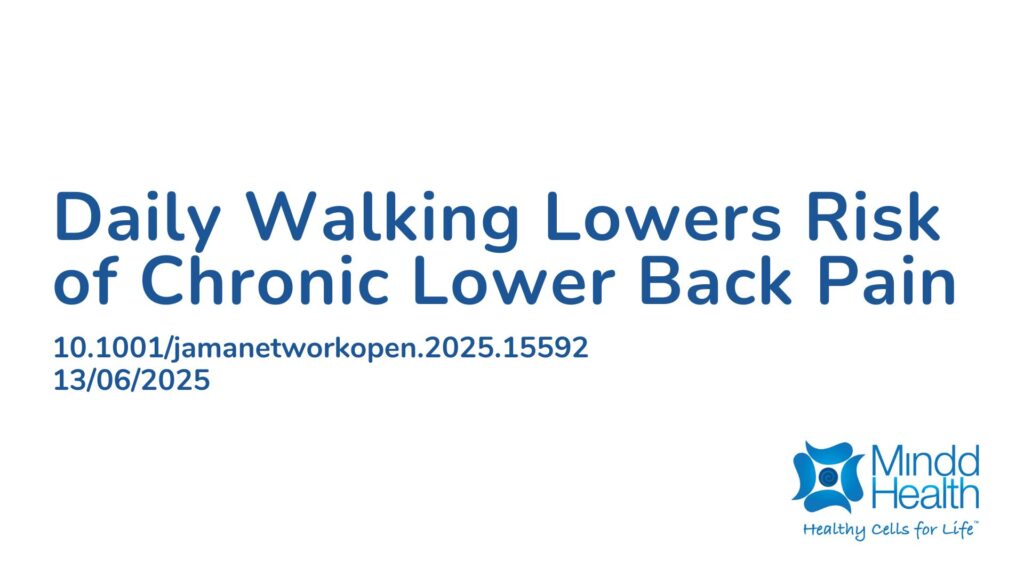Summary:
Low back pain (LBP) is a common condition affecting people of all ages and is a leading cause of disability worldwide. While staying physically active is recommended for managing chronic LBP, there is limited guidance on whether physical activity can prevent chronic LBP in people without symptoms. Walking, the most common form of leisure activity, is known to reduce the risk of several health conditions, but its effect on preventing chronic LBP has not been well studied. This study examined whether daily walking and walking intensity are linked to the risk of developing chronic LBP. Data were used from the Norwegian Trøndelag Health Study, including adults without chronic LBP at baseline who had at least one day of walking (device-measured). Walking was measured both as total minutes per day and as intensity. Chronic LBP at follow-up was defined as pain lasting three months or longer within the past year. Among 11,194 participants followed for an average of 4.2 years, 14.8% developed chronic LBP. Higher daily walking time and greater walking intensity were associated with a lower risk of chronic LBP. For example, walking 101 to 124 minutes per day reduced the risk by about 23% compared with walking less than 78 minutes per day. Higher walking intensity also reduced risk. These findings suggest that walking regularly may help prevent chronic LBP. Promoting daily walking could be a practical strategy to reduce the future burden of chronic LBP.
Abstract:
Importance Chronic low back pain (LBP) is a prevalent and costly condition, and regular physical activity may reduce its risk. Walking is a common and accessible form of physical activity, but its association with the risk of chronic LBP is unclear. Objective To examine whether accelerometer-derived daily walking volume and walking intensity are associated with the risk of chronic LBP. Design, Setting, and Participants This prospective population-based cohort study used data from the Trøndelag Health (HUNT) Study in Norway, with a baseline in 2017 to 2019 and follow-up in 2021 to 2023. The study included individuals without chronic LBP at baseline and with at least 1 valid day of device-measured walking. Exposure Daily walking volume (minutes per day) and walking intensity, expressed as metabolic equivalent of task (MET) per minute. Main Outcomes and Measures The primary outcome was self-reported chronic LBP at follow-up, defined as pain lasting 3 months or longer in the past 12 months. Poisson regression was used to estimate adjusted risk ratios (RRs) with 95% CIs of chronic LBP according to daily walking volume and mean walking intensity. Results A total of 11 194 participants aged 20 years or older (mean [SD] age, 55.3 [15.1] years; 6564 women [58.6%]) were included in the analysis. At follow-up (mean [SD] follow-up time, 4.2 [0.3] years), 1659 participants (14.8%) reported chronic LBP. Continuous measures of both walking volume and walking intensity were inversely associated with the risk of chronic LBP using restricted cubic splines models. Compared with participants walking less than 78 minutes per day, those walking 78 to 100 minutes per day had an RR for chronic LBP of 0.87 (95% CI, 0.77-0.98), those walking 101 to 124 minutes per day had an RR of 0.77 (95% CI, 0.68-0.87), and those walking 125 minutes or more per day had an RR of 0.76 (95% CI, 0.67-0.87). Compared with a mean walking intensity of less than 3.00 MET per minute, participants with walking intensity of 3.00 to 3.11 MET per minute had an RR for chronic LBP of 0.85 (95% CI, 0.75-0.96), those with walking intensity of 3.12 to 3.26 MET per minute had an RR of 0.82 (95% CI, 0.72-0.93), and those with walking intensity greater than or equal to 3.27 MET per minute had an RR of 0.82 (95% CI, 0.72-0.93). After mutual adjustment, the association remained largely similar for walking volume but was attenuated for walking intensity. Conclusions and Relevance In this cohort study, daily walking volume and walking intensity were inversely associated with the risk of chronic LBP. The findings suggest that walking volume may have a more pronounced benefit than walking intensity.
Article Publication Date: 13/06/2025
DOI: 10.1001/jamanetworkopen.2025.15592



